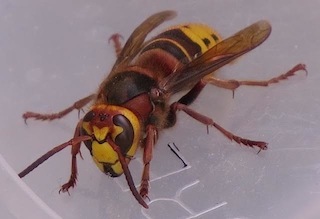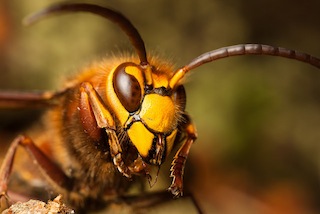 Hornets are not anything like as fearsome as they look.
Hornets are not anything like as fearsome as they look.
Photo: Ray Surridge
Scientific name: Vespa crabro
Other common names: European Hornet
What to look for:
- Colouring: Looking like a large wasp, it is striped yellow and brown with reddish wings and C-shaped eyes.
- Size: Length, 2 to 3 cm.
- Where: Common in the south of Britain.
- When: May to September.
- Similar species: Common Wasp, which is smaller and striped black, rather than brown, and yellow.
 If you don’t like wasps, then you almost certainly won’t like Hornets. Bigger than their waspy cousins, and striped in brown and yellow, rather than black and yellow, they can be a fearsome sight. This reaction isn’t at all justified, however. They can sting, and will do if attacked or when defending their hive or food against real or perceived threats, but they are in fact much less aggressive than other wasps.
If you don’t like wasps, then you almost certainly won’t like Hornets. Bigger than their waspy cousins, and striped in brown and yellow, rather than black and yellow, they can be a fearsome sight. This reaction isn’t at all justified, however. They can sting, and will do if attacked or when defending their hive or food against real or perceived threats, but they are in fact much less aggressive than other wasps.
Like other Vespa species, the Hornet is a social insect and has a very similar life cycle. After a solitary hibernation through the winter, the queen emerges in the spring and starts to build her papery nest, usually in a hollow tree, created from chewing wood pulp. She lays her fertilised eggs (queens mate towards the end of summer, before hibernating), which produce sterile female worker hornets that continue building the nest and tending the grubs. The queen lays more eggs in the early autumn, and then dies. These eggs develop into fertile females (new queens) and males that mate, after which the males die, and so the cycle continues with the new queens leaving to find a secure place to hibernate.
 Although the queens gain energy by eating nectar before hibernating, the Hornet’s diet consists mainly of other insects. These include many pest species, so gardeners should be glad to see Hornets.
Although the queens gain energy by eating nectar before hibernating, the Hornet’s diet consists mainly of other insects. These include many pest species, so gardeners should be glad to see Hornets.
Did you know…?
…Hornets fly by day, but will also fly at night if there is enough light.
…The Hornet is reasonably common in southern England and is spreading northwards as its population recovers from very low numbers in the 1960s.
More information and references:
Chinery, M., 2005. Collins Complete Guide to British Insects. Collins, London.
Published: August 2015
Author: Amanda Scott
Photos: Upper (Ray Surridge); lower (© Natural England/Allan Drewitt)
